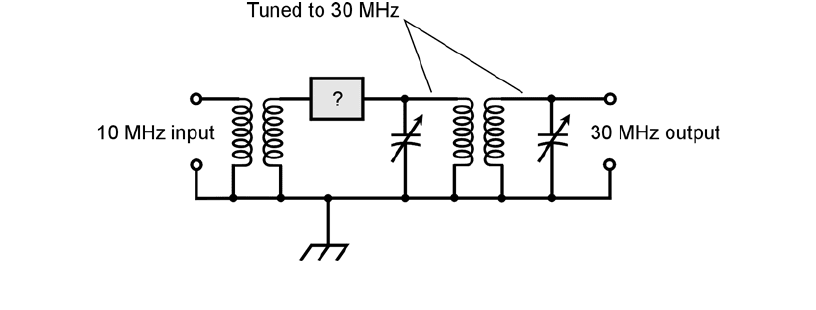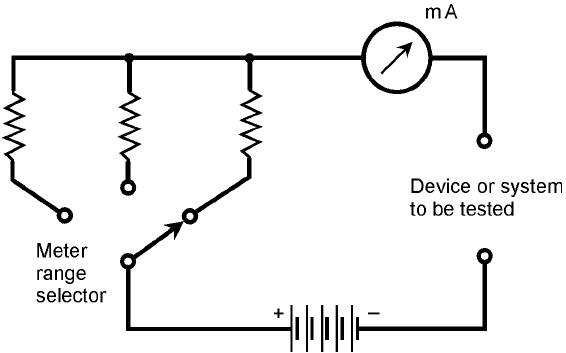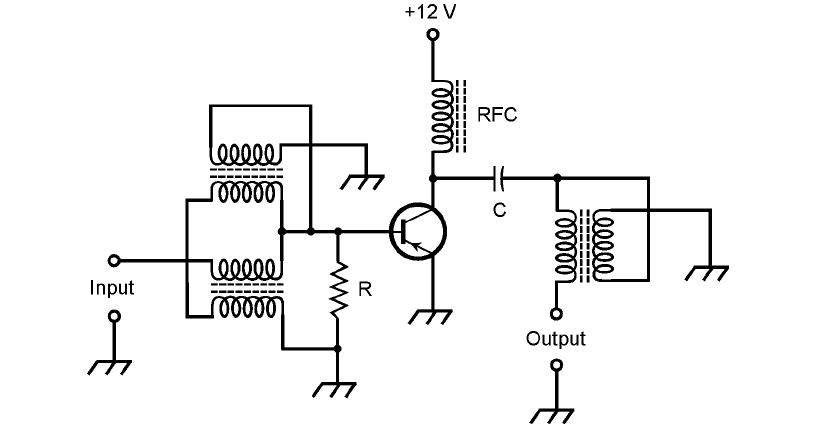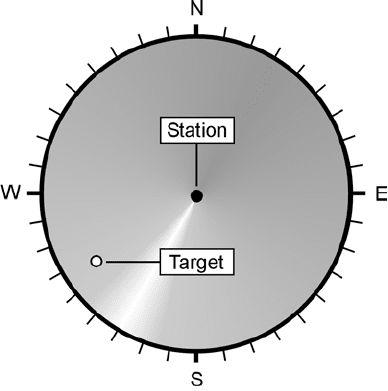Gibilisco S. Teach Yourself Electricity and Electronics
Подождите немного. Документ загружается.

(c) The current leads the voltage by 90°.
(d) The current lags the voltage by 90°.
(e) None of the above are true.
48. Suppose you want to use a transformer to match the output of an audio amplifier to a speaker.
The amplifier has a purely resistive output impedance of exactly 128 Ω. The speaker has a purely
resistive impedance of exactly 8 Ω. The primary-to-secondary turns ratio of the transformer should be
(a) exactly 1:16.
(b) exactly 1:4.
(c) variable.
(d) exactly 4:1.
(e) exactly 16:1.
49. Imagine a string of 20 holiday lights, all connected in parallel and plugged into a 120-V rms
ac wall outlet. If one of the bulbs is short-circuited, what will happen?
(a) All of the remaining 19 bulbs will shine a little more brightly than before.
(b) All of the remaining 19 bulbs will shine a little less brightly than before.
(c) The fuse or circuit breaker will blow, and all of the remaining 19 bulbs will go out.
(d) Most of all of the remaining 19 bulbs will burn out, and some may explode.
(e) The remaining 19 bulbs will continue to shine exactly as before—no more or less brightly.
50. Suppose a coil and capacitor are connected in series, with jX
L
= j 40 and jX
C
=−j70, and the
coil has an internal resistance of 10 Ω. Suppose the frequency of operation is 12.5 MHz. This
circuit will exhibit resonance at
(a) some frequency below 12.5 MHz.
(b) some frequency above 12.5 MHz.
(c) 12.5 MHz; it is resonant under the conditions stated.
(d) any and all frequencies.
(e) no frequency, because of the internal resistance.
51. Imagine a transmission line consisting of two wires, each having a diameter of exactly 1 mm,
and uniformly spaced exactly 10 mm apart with nothing but air as the dielectric between them. If
the two wires are moved so they are uniformly spaced exactly 50 mm apart, and the dielectric
between them is still nothing but air, what happens to the characteristic impedance?
(a) It does not change.
(b) It increases.
(c) It decreases.
(d) It is impossible to say without knowing what is connected to the line.
(e) It is impossible to say without knowing the frequency.
52. In an FM signal, deviation is
(a) the difference between the highest instantaneous carrier frequency and the lowest
instantaneous carrier frequency.
(b) the maximum extent to which the instantaneous carrier frequency differs from the
unmodulated-carrier frequency.
Final Exam 631
(c) the bandwidth of the signal, expressed in hertz, kilohertz, or megahertz.
(d) the rate at which the phase of the signal varies, expressed in hertz per second, kilohertz
per millisecond, or megahertz per microsecond.
(e) None of the above is true.
53. A typical angular speed for an old-fashioned vinyl disk in a hi-fi sound system is
(a) 12 rpm.
(b) 24 rpm.
(c) 33 rpm.
(d) 60 rpm.
(e) 90 rpm.
54. An autotransformer can be recognized by the fact that it has
(a) a continuously adjustable turns ratio.
(b) a solenoidal core that can be moved in and out of a coil.
(c) a single, tapped winding.
(d) a special set of terminals for use with an automotive battery.
(e) a toroidal core.
55. One of the purposes of the suppressor grid in a pentode vacuum tube amplifier is to
(a) keep the cathode from emitting too many electrons, which could drive the control grid
current to excessive levels.
(b) ensure that the plate is maintained at a constant negative voltage, so electrons will not be
attracted to it.
(c) prevent the screen grid from shorting out to the plate, which could cause the power
supply to burn out.
(d) repel secondary electrons emitted by the plate, keeping the screen grid current from
getting too high.
(e) prevent distortion caused by overdrive in the control grid, screen grid, or cathode circuits.
56. Consider two sine waves having identical frequency. Suppose that one wave leads the other
by exactly
1
⁄20 of a cycle. What is the phase difference between the two waves?
(a) 9°
(b) 12°
(c) 18°
(d) 20°
(e) 24°
57. In a cellular communications system, a technology in which cells overlap, but signals do not
interfere with each other because every phone set is assigned a unique signal code, is known as
(a) code-division multiple access.
(b) diversity reception.
(c) a phase-locked loop.
632 Final Exam

(d) analog signal mixing.
(e) digital diversity encryption.
58. A steady magnetic field can be produced by
(a) a straight wire carrying a constant direct current.
(b) a loop of wire carrying a constant direct current.
(c) a coil of wire carrying a constant direct current.
(d) a constant-intensity stream of protons in free space, moving in a straight line.
(e) any of the above.
Final Exam 633
Exam-3 Illustration for Final Exam Question 59.
59. In Fig. Exam-3, what type of component can the box with the query symbol (?) contain in
order for the circuit to function as indicated?
(a) A capacitor
(b) A resistor
(c) A battery
(d) An inductor
(e) A diode
60. The binary number 1001101 represents which decimal number?
(a) 44
(b) 55
(c) 66
(d) 77
(e) 88
61. Suppose a dc circuit has 10 kΩ of resistance, and a 12-V battery is connected to it. How
much power is drawn from the battery?
(a) 1.2 µW
(b) 12 µW

(c) 1.2 mW
(d) 12 mW
(e) None of the above
62. In which of the following applications would you never find an op amp used as the main
active circuit component?
(a) A differentiator
(b) An integrator
(c) A highpass audio filter
(d) A lowpass audio filter
(e) A microwave oscillator
63. Imagine a circuit with 21 Ω of inductive reactance and 28 Ω of resistance. What is the
complex impedance of this circuit?
(a) 7 Ω
(b) 24 Ω
(c) 35 Ω
(d) 49 Ω
(e) None of the above
64. In a circuit containing conductance, inductive susceptance, and capacitive susceptance, a
condition of resonance exists if and only if
(a) the conductance is zero.
(b) the conductance is infinite.
(c) the inductive susceptance is infinite and the capacitive susceptance is zero.
(d) the inductive and capacitive susceptances are both zero.
(e) the inductive and capacitive susceptances cancel out.
65. Imagine a perfect square wave with no dc component. That means the positive and negative
portions have equal amplitudes and equal durations. Suppose you are told that the voltage is 10.0
V pk-pk. What is the average voltage?
(a) 0.00 V
(b) 5.00 V
(c) 7.07 V
(d) 10.0 V
(e) It is impossible to calculate this without more information.
66. Fill in the blank in the following statement to make it true: “It takes a certain minimum
voltage, known as the forward breakover voltage, for conduction to occur through a P-N junction.”
(a) RF
(b) AF
(c) forward bias
(d) negative
(e) positive
634 Final Exam

67. Figure Exam-4 is a generic diagram of a device that can be used to measure
(a) dc voltage.
(b) dc resistance.
(c) dc power.
(d) ac voltage.
(e) ac power.
68. Suppose an audio amplifier produces 8.0 V rms output with 80 mV rms input. Suppose the
amplifier input impedance is the same as the output load impedance. What is the gain of this
amplifier in this situation?
(a) 20 dB
(b) 40 dB
(c) 100 dB
(d) 200 dB
(e) We must know the actual input and output impedance values, in ohms, in order to
determine the gain in this case.
69. The maximum gain obtainable with an amplifier that employs a given bipolar transistor
(a) gradually increases as the frequency increases.
(b) stays the same as the frequency increases.
(c) gradually decreases as the frequency increases.
(d) alternately increases and decreases as the frequency increases.
(e) remains constant up to a certain frequency, and then abruptly drops to zero above that
frequency.
70. A phase comparator would most likely be found in
(a) an AF oscillator.
(b) an AM detector.
Final Exam 635
Exam-4 Illustration for
Final Exam
Question 67.
(c) an RF power amplifier.
(d) a PLL frequency synthesizer.
(e) An antenna tuning network.
71. An atom with 7 protons and 5 electrons is an example of
(a) a positive isotope.
(b) a negative isotope.
(c) a positive ion.
(d) a negative ion.
(e) a neutral ion.
72. Electrical energy can be derived from hydrogen on a small scale in a device called
(a) an electrolytic cell.
(b) an alkaline cell.
(c) a fission cell.
(d) a fusion cell.
(e) a fuel cell.
73. The output wave of a common-gate amplifier circuit with a pure sine-wave input
(a) is in phase with the input wave.
(b) lags the input wave by 90° of phase.
(c) leads the input wave by 90° of phase.
(d) is 180° out of phase with the input wave.
(e) is inverted with respect to the input wave.
74. Which of the following capacitor types is polarized?
(a) Electrolytic
(b) Paper
(c) Ceramic
(d) Mica
(e) Air variable
75. The maximum radiation and response from a full-wave loop antenna, assuming there are no
nearby conductors or obstructions to distort the pattern, occurs
(a) in the plane of the loop.
(b) perpendicular to the plane of the loop.
(c) at 45° angles to the plane of the loop.
(d) parallel to the horizon, in all directions of the compass.
(e) in all directions in three dimensions; it is a true omnidirectional antenna.
76. Suppose that five resistors, each having a different ohmic value from any of the others, are
connected in series, and the entire combination is connected to a 12-V battery. How does the
current through any one of the resistors compare with the current drawn from the battery?
636 Final Exam

(a) The current through any one of the resistors is more than the current drawn from the
battery.
(b) The current through any one of the resistors is the same as the current drawn from the
battery.
(c) The current through any one of the resistors is less than the current drawn from the
battery.
(d) It depends on the relative ohmic values of the resistors.
(e) None of the above statements are true.
77. Suppose a battery-powered circuit has 1.00 Ω of net resistance, and 15.0 A of current flows
through it. How much power is demanded from the battery?
(a) 225 W
(b) 150 W
(c) 22.5 W
(d) 66.7 mW
(e) It is impossible to calculate this, based on the information given.
Final Exam 637
Exam-5 Illustration for Final Exam Question 78.
78. Figure Exam-5 shows a generic circuit that can be used for broadband RF power
amplification. What is wrong with the circuit as shown?
(a) The resistor, R, should be replaced with a capacitor.
(b) The capacitor, C, should be replaced with a resistor.
(c) The +12-V power source should be replaced with a −12-V power source.
(d) The choke, RFC, should be replaced with a capacitor.
(e) Nothing is wrong with this circuit.
79. Imagine a string of 20 holiday lights, all connected in parallel and plugged into a 120-V rms
ac wall outlet. If one of the bulbs is unscrewed and removed from the circuit, what will happen?
(a) All of the remaining 19 bulbs will shine a little more brightly than before.
(b) All of the remaining 19 bulbs will shine a little less brightly than before.
(c) The fuse or circuit breaker will blow, and all of the remaining 19 bulbs will go out.
(d) Most of all of the remaining 19 bulbs will burn out, and some may explode.
(e) The remaining 19 bulbs will continue to shine exactly as before—no more or less
brightly.
80. When a volatile RAM chip is used in a computer,
(a) the contents of the memory can be easily overwritten.
(b) the contents of the memory remain intact even if power is removed.
(c) data in memory cannot be transferred to or from external media.
(d) the contents of memory never last more than a few minutes.
(e) excessive ELF radiation is produced.
81. A nickel-cadmium (NICAD) battery should never be discharged until it is totally dead
because
(a) the battery may explode.
(b) the battery will have excessive voltage after it is recharged.
(c) the battery will develop unwanted inductance after it is recharged.
(d) the polarity of one or more of the cells may reverse, ruining the battery.
(e) Forget it! There is no problem with discharging a NICAD battery until it is totally dead.
82. Which of the following is an advantage of a CRT display over an LCD for a computing
workstation?
(a) You can get a bigger screen for a lower price.
(b) The CRT emits less ELF energy.
(c) The CRT is less massive.
(d) The CRT takes up less space on the desk.
(e) All of the above are true.
83. The gauss is a unit of
(a) charge carrier flow speed.
(b) magnetic flux density.
(c) electrostatic field strength.
(d) electromagnetic field intensity.
(e) electrical charge quantity.
638 Final Exam
84. Imagine an inductor and resistor connected in series, such that the inductive reactance is
300 Ω and the resistance is 500 Ω at a particular frequency. If the frequency is decreased, what
happens to the relative phase of the instantaneous current and the instantaneous voltage?
(a) Their relative phase does not change.
(b) They become more nearly in phase.
(c) They become more out of phase.
(d) They go alternately into and out of phase.
(e) It is impossible to say anything about this without more information.
85. Imagine two sine waves, one with a frequency of 50.00 Hz and the other with a frequency of
60.00 Hz. The phase difference between these two waves is
(a) not definable.
(b) 10.00°.
(c) 10.00%.
(d) 16.67%.
(e)
5
⁄6 of a radian.
86. Consider a variable capacitor connected in parallel with a fixed toroidal inductor. Suppose a
signal of constant frequency is applied to the combination. If the variable capacitor is adjusted so
its value changes from 200 pF to 100 pF, what happens to the reactance of the inductor?
(a) It doubles.
(b) It becomes half as great.
(c) It quadruples.
(d) It becomes
1
⁄4 as great.
(e) It does not change.
87. When two inductors having the same value are connected in series with a small opposing
mutual inductance (say the coefficient of coupling is 5 percent or so), the total reactance of the
combination at a specific, constant frequency is
(a) equal to the reactance of either inductor.
(b) slightly greater than the reactance of either inductor.
(c) slightly less than the reactance of either inductor.
(d) slightly greater than twice the reactance of either inductor.
(e) slightly less than twice the reactance of either inductor.
88. The power factor in an ac circuit is defined as
(a) the actual power divided by the maximum power the circuit can handle.
(b) the ratio of the real power to the imaginary power.
(c) the ratio of the apparent power to the true power.
(d) the ratio of the true power to the apparent power.
(e) the ratio of the imaginary power to the apparent power.
Final Exam 639

89. Figure Exam-6 shows a radar display and a single blip, indicating the position of a target.
What is the approximate azimuth of this target?
(a) 122°
(b) 212°
(c) 238°
(d) 148°
(e) More information is needed to answer this.
90. Which of the following is an e-mail address in the proper format?
(a) www.sciencewriter.net
(b) members.authorsguild.net/stangib
(c) sciencewriter@tahoe.com
(d) http://google.com
(e) All of the above
91. A robot can be guided along a specific route by means of a current-carrying wire beneath the
surface. The robot detects, and follows, the magnetic field produced by the current, thus following
the wire. This is called
(a) an epipolar system.
(b) a fluxgate magnetometer.
(c) a servo system.
(d) an electromagnetic router.
(e) an embedded path.
640 Final Exam
Exam-6 Illustration for
Final Exam
Question 89.
